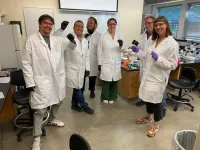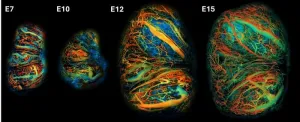(Press-News.org) Scientists believe that planetary systems like our solar system contain more rocky objects than gas-rich ones. Around our sun, these include the inner planets – Mercury, Venus, Earth and Mars – the asteroid belt and the Kuiper belt objects such as Pluto.
Jupiter, Saturn, Uranus and Neptune, on the other hand, contain mostly gas. But scientists also have known for a long time that planet-forming disks start out with 100 times more mass in gas than solids, which leads to a pressing question: When and how does most of the gas leave a nascent planetary system?
A new study led by Naman Bajaj at the University of Arizona Lunar and Planetary Laboratory, published in the Astronomical Journal, provides answers. Using the James Webb Space Telescope, or JWST, the team obtained images from such a nascent planetary system – also known as a circumstellar disk – in the process of actively dispersing its gas into surrounding space.
"Knowing when the gas disperses is important as it gives us a better idea of how much time gaseous planets have to consume the gas from their surroundings," said Bajaj, a second-year doctoral student at UArizona's Lunar and Planetary Laboratory. "With unprecedented glimpses into these disks surrounding young stars, the birthplaces of planets, JWST helps us uncover how planets form."
During the very early stages of planetary system formation, planets coalesce in a spinning disk of gas and tiny dust around the young star, according to Bajaj. These particles clump together, building up into bigger and bigger chunks called planetesimals. Over time, these planetesimals collide and stick together, eventually forming planets. The type, size and location of planets that form depend on the amount of material available and how long it remains in the disk.
"So, in short, the outcome of planet formation depends on the evolution and dispersal of the disk," Bajaj said.
At the heart of this discovery is the observation of T Cha, a young star – relative to the sun, which is about 4.6 billion years old – enveloped by an eroding circumstellar disk notable for a vast dust gap, spanning approximately 30 astronomical units, or au, with one au being the average distance between the Earth and the sun.
Bajaj and his team were able, for the first time, to image the disk wind, as the gas is referred to when it slowly leaves the planet-forming disk. The astronomers took advantage of the telescope's sensitivity to light emitted by an atom when high-energy radiation – for example, in starlight – strips one or more electrons from its nucleus. This is known as ionization, and the light emitted in the process can be used as a sort of chemical "fingerprint" – in the case of the T Cha system, tracing two noble gases, neon and argon. The observations also mark the first time a double ionization of argon has been detected in a planet-forming disk, the team writes in the paper.
"The neon signature in our images tells us that the disk wind is coming from an extended region away from the disk," Bajaj said. "These winds could be driven either by high-energy photons – essentially the light streaming from the star – or by the magnetic field that weaves through the planet-forming disk."
In an effort to differentiate between the two, the same group, this time led by Andrew Sellek, a postdoctoral researcher at Leiden University in the Netherlands, performed simulations of the dispersal driven by stellar photons, the intense light streaming from the young star. They compared these simulations to the actual observations and found dispersal by high-energy stellar photons can explain the observations, and hence cannot be excluded as a possibility. That study concluded that the amount of gas dispersing from the T Cha disk every year is equivalent to that of Earth's moon. These results will be published in a companion paper, currently under review with the Astronomical Journal.
While neon signatures had been detected in many other astronomical objects, they weren't known to originate in low-mass planet-forming disks until first discovered in 2007 with JWST's predecessor, NASA's Spitzer Space Telescope, by Ilaria Pascucci, a professor at LPL who soon identified them as a tracer of disk winds. Those early findings transformed research efforts focused on understanding gas dispersal from circumstellar disks. Pascucci is the principal investigator on the most recent observing project and a co-author on the publications reported here.
"Our discovery of spatially resolved neon emission – and the first detection of double ionized argon – using the James Webb Space Telescope could become the next step towards transforming our understanding of how gas clears out of a planet-forming disk," Pascucci said. "These insights will help us get a better idea of the history and impact on our own solar system."
In addition, the group has also discovered that the inner disk of T Cha is evolving on very short timescales of decades; they found that the spectrum observed by JWST differs from the earlier spectrum detected by Spitzer. According to Chengyan Xie, a second-year doctoral student at LPL who leads this in-progress work, this mismatch could be explained by a small, asymmetric disk inside of T Cha that has lost some of its mass in the short 17 years that have elapsed between the two observations.
"Along with the other studies, this also hints that the disk of T Cha is at the end of its evolution," Xie said. "We might be able to witness the dispersal of all the dust mass in T Cha's inner disk within our lifetime."
Co-authors on the publications include Uma Gorti with the SETI Institute, Richard Alexander with the University of Leicester, Jane Morrison and Andras Gaspar with the UArizona's Steward Observatory, Cathie Clarke with the University of Cambridge, Giulia Ballabio with Imperial College London, and Dingshan Deng with the Lunar and Planetary Laboratory.
END
James Webb Space Telescope captures the end of planet formation
How much time do planets have to form from a swirling disk of gas and dust around a star? A new University of Arizona-led study gives scientists a better idea of how our own solar system came to be.
2024-03-22
ELSE PRESS RELEASES FROM THIS DATE:
If faces look like demons, you could have this extraordinary condition
2024-03-22
Imagine if every time you saw a face, it appeared distorted. Well, for those who have a very rare condition known as prosopometamorphopsia (PMO), which causes facial features to appear distorted, that is reality.
As the Dartmouth-based website about prosopometamorphopsia explains, "'Prosopo' comes from the Greek word for face 'prosopon' while 'metamorphopsia' refers to perceptual distortions.''' Specific symptoms vary from case to case and can affect the shape, size, color, and position ...
Birmingham scientists win funding to develop “lollipops” for mouth cancer diagnosis
2024-03-22
VIDEO available to download HERE of scientist Ruchi Gupta explaining how she hopes to make a lollipop or lozenge to diagnose mouth cancer. The film features mouth cancer survivor Rachel Parsons and contains explicit images.
A ‘LOLLIPOP’ that can diagnose mouth cancer early could become a reality, thanks to a pioneering project funded by Cancer Research UK and the Engineering and Physical Sciences Research Council (EPSRC).
Dr Ruchi Gupta at the University of Birmingham has been awarded £350,000 over the next three years by Cancer Research UK and EPSRC to make a prototype flavoured ‘lollipop’ from a material called a smart hydrogel.
Smart ...
Reviving England’s polluted rivers? Incentivising farmers and comprehensive monitoring among key recommendations from experts
2024-03-22
At the close of 2023, Defra asked the British Ecological Society to bring together nearly 40 experts, to collate expert opinion on freshwater policy and set out a list of priorities for the biodiversity evidence programme to focus on. Published today, the new report sets out priorities for restoring England’s polluted fresh waters.
We know that England’s rivers, and the life they support, are in a desperate state. The River Trust’s annual State of Our Rivers report found that a mere 15% of rivers in England were classed as being in good ecological health and no ...
NASA’s tiny BurstCube mission launches to study cosmic blasts
2024-03-22
NASA’s BurstCube, a shoebox-sized satellite designed to study the universe’s most powerful explosions, is on its way to the International Space Station.
The spacecraft travels aboard SpaceX’s 30th Commercial Resupply Services mission, which lifted off at 4:55 p.m. EDT on Thursday, March 21, from Launch Complex 40 at Cape Canaveral Space Force Station in Florida. After arriving at the station, BurstCube will be unpacked and later released into orbit, where it will detect, locate, and study short gamma-ray ...
Research reveals link between menstrual cycles, emotions, and sleep patterns in women
2024-03-22
Women experience disruptions in their sleep patterns and report heightened feelings of anger in the days leading up to their period, according to new research.
The study sheds new light on the intricate relationship between women's menstrual cycles, emotions, and sleep patterns.
Co-author Dr Jo Bower, of the University of East Anglia’s School of Psychology, said: “Our research provides valuable insights into the complex interplay between menstrual cycles, emotions, ...
Breast cancer patients can safely avoid extensive removal of lymph nodes if they respond well to primary systemic treatment
2024-03-22
Milan, Italy: Patients with breast cancer that has started to spread to the lymph nodes in the armpit can safely avoid extensive removal of the lymph nodes if their treatment is tailored to their response to cancer-killing therapies such as chemotherapy before surgery.
In a presentation to the 14th European Breast Cancer Conference today (Friday) in Milan, Annemiek Van Hemert, a doctor and PhD student in the Surgical Oncology Department of Antoni van Leeuwenhoek-Netherlands Cancer Institute (AVL-NKI) in Amsterdam (The Netherlands), said: “If we are able to predict the response based on the removal of ...
Replacing sugar with sweeteners can improve weight loss control over the long-term in adults in the overweight range, finds European randomised controlled trial
2024-03-21
*This is an early press release from the European Congress on Obesity (ECO 2024) Venice 12-15 May. Please credit the Congress if using this material*
New research being presented at this year’s European Congress on Obesity (ECO) in Venice, Italy (12-15 May), suggests that replacing sugar-sweetened food and drinks with low/no energy sweetened products can help weight control for at least one year after rapid weight loss in adults, without increasing the risk of type 2 diabetes or cardiovascular disease.
The findings of a year-long randomised controlled trial involving adults with overweight and obesity and children in the overweight range from Northern, Central and ...
Early registration opens for 2024 International Space Station Research and Development Conference in Boston
2024-03-21
BOSTON (MA), March 21, 2024 – This July, the 13th annual International Space Station Research and Development Conference (ISSRDC) returns to Boston, where leaders from the commercial sector, U.S. government agencies, and academic communities will assemble to highlight innovations and opportunities through our nation’s orbiting outpost. ISSRDC will take place July 30-August 1, 2024, at the Marriott Copley Place in Boston. Early registration is now open until May 24, 2024. Booking during early ...
Marine Biological Laboratory announces 2024 Logan Science Journalism Fellows
2024-03-21
WOODS HOLE, Mass. –Twelve accomplished science and health journalists have been awarded a highly competitive fellowship in the Logan Science Journalism Program at the Marine Biological Laboratory (MBL).
Now in its 37th year, the Logan Science Journalism Program provides journalists with immersive, hands-on research training, giving them invaluable insight into the practice of science as well as some of the major news stories of today. The program, which offers a Biomedical course and an Environmental course, will run May 13-23 in Woods Hole.
Biographies for the 2024 Logan Science Journalism Fellows are here. They are:
Biomedical Fellows
Pakinam Amer, Independent ...
Novel imaging platform allows researchers to study placental development in pregnant mice
2024-03-21
DURHAM, N.C. -- Physicians and biomedical engineers at Duke University have developed a method to visualize the growth of a placenta throughout a mouse’s pregnancy. By coupling an implantable window with ultrafast imaging tools, the approach provides the first opportunity to track placental development to better understand how the organ functions during pregnancy.
This new perspective gives researchers a precise way to examine how lifestyle factors like alcohol consumption and health complications like inflammation can affect the placenta and potentially lead to adverse pregnancy outcomes.
The research appears March 20 as the cover ...
LAST 30 PRESS RELEASES:
School meals could unlock major gains for human and planetary health
Menopause hormone therapy does not appear to impact dementia risk
Signature patterns of brain activity may help predict recovery from traumatic brain injury
Dresden study uncovers new key mechanism in cancer cells
New species are now being discovered faster than ever before, study suggests
Cannabis-based products show limited short-term benefit for chronic pain, with increased risk of adverse effects
Cannabis products with more THC slightly reduce pain but cause more side effects
Clearing the brain of aging cells could aid epilepsy and reduce seizures
Brain injuries linked with potential risk of suicide, new study finds
New technique lights up where drugs go in the body, cell by cell
New study finds movement of fishing fleets can reveal shifts in marine ecosystems
Embargoed: New evidence points to potential treatment for vascular dementia
Study uncovers disrupted brain balance in alcohol dependence
Working in groups can help Republicans and Democrats agree on controversial content moderation online
Structural findings reveal how distinct GPCR ligands create different levels of activation
Anything-goes “anyons” may be at the root of surprising quantum experiments
UC review: Maximizing workplace opportunity for veterans
From generation to complex control: Metasurfaces make perfect vortex beams "within reach"
Thin-film lithium niobate-based detector: recent advances and perspectives
Exploring why some people may tend to persistently make bad choices
How cells balance their protein levels
Nirsevimab vs RSVpreF vaccine for RSV–related hospitalization in newborns
Effectiveness and impact of maternal RSV immunization and nirsevimab on medically attended RSV in US children
AI gives scientists a boost, but at the cost of too many mediocre papers
Next-generation vision model maps tree growth at sub-meter precision
Genes aren’t destiny for inherited blindness, study shows
MIT study: High-fat diets make liver cells more likely to become cancerous
Exposure to multiple fine particulate matter components and incident depression in the US Medicare population
Risk of burdensome health care spending over time in the US
Nirsevimab against hospitalizations and emergency department visits for lower respiratory tract infection in infants
[Press-News.org] James Webb Space Telescope captures the end of planet formationHow much time do planets have to form from a swirling disk of gas and dust around a star? A new University of Arizona-led study gives scientists a better idea of how our own solar system came to be.







